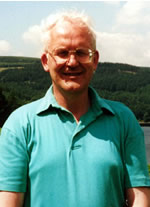 |
 |
 |
 |
|
Chemical Education International, Vol. 2, Issue 1, 18-19, Published in August 3, 2001 Report on 16th ICCE, Budapest, 5-10 August 2000
Peter
E. Childs The International Conference on Chemical Education is held every two years in different countries. The first one I attended was in 1979 when the 5th. ICCE was held in Dublin. I have been to a number of them since then but the last one I attended was in 1991 in York. Since then the ICCE has visited Brazil, Australia, Thailand and Egypt! The 17th. ICCE will be held in Beijing, China in 2002. The ICCE is a big international jamboree: over 500 people were present in Hungary (including over 200 from Hungary itself) for the 16th. ICCE (Photos 1 and 2). There were large groups from the USA and UK, and only one from Ireland. One problem with these large international conferences is that the fees are very high ($400) and this discourages teachers and people from developing countries from attending, especially when added to the cost of getting there. The attendance from Africa and S. America was noticeably small. Members of the RSC's Education Division can apply for a grant and I would like to thank them for a grant of 250 pounds towards the registration fee. Hungary is also fairly expensive to get to and accommodation is not especially cheap, although meals are very good value. Whenever I attend one of these large meetings I ask myself "was it worth it?" and "what is the benefit of this sort of conference?" In my opinion the main value of the ICCEs is that they enable local teachers and lecturers, from the country or region where it is held, to benefit from hearing a range of international speakers and become part (for a short time) of the international chemical education network. Too often, particularly if you attend several successive conferences, it seems that little new is being said, that the wheel continues to be reinvented, and the same speakers say much the same thing conference after conference. However, for the people from the host country or region this is new and valuable, and this justifies the expense of such meetings. More effort needs to be made to raise scholarships for people coming from less-developed countries, so they feel part of the chemical education scene and can share their unique contributions. I had been looking forward to the plenary lectures by two Nobel laureates: Sir Harry Kroto (for his discovery of buckyballs) and Paul Crutzen (for his work on ozone depletion). Harry Kroto talked mainly about the popularisation of science and the work of Vega Trust, which he's set up to produce science programmes for TV. He is an enthusiastic and engaging speaker, as you will know if you saw the BBC TV Horizon film 'Molecules with Sunglasses' on the discovery of buckyballs. A research proposal to continue this work was turned down by the funding council in the UK on the same day that his Nobel Prize was announced! They later said that this was a mistake and gave him the money. Paul Crutzen gave an overview of his work on ozone depletion and the current status of this work (Photo 3). However, the best plenary lecture, both in presentation and content, was that given by V.K. Obendrauf, an Austrian chemistry teacher on 'low-cost experiments with gases'. This was a tour de force of chemical demonstration and modern AV technology. He showed how to make and test gases safely on a small scale, using plastic syringes, backed up by an effective use of modern technology: Powerpoint slides interspersed with live video showing the experiments in close-up to an audience of 500. Very impressive and educative. There was whole series of parallel symposia and workshops on a wide variety of topics, which meant one could only sample a small amount of what was on offer. I was involved in a symposium on Industry-Education Cooperation chaired by Peter Towse (Leeds), who I first met nearly 30 years in East Africa. Peter has just produced the latest edition of Chemical Education Journals, giving details of science/chemistry/education journals around the world. There was also an extensive display of posters, and an exhibition on the History of Hungarian Science and on Justus von Liebig (in German). Another interesting aspect of the building the conference was held in was a display of sculpture inspired by chemistry, by a member of the chemistry department at Eotvos University. There was a display of posters on the conference themes, including many put on by local teachers. The large crowd of enthusiastic and energetic Hungarian second-level teachers (photos 4, 5 and 6) was a major feature of the conference. There were also several commercial displays of equipment and books, not to mention Gordon Woods' periodic table collection of ties, scarves, tea cloths, mousemats etc.(photo7) Budapest is a lovely city to visit and one of the main things to strike someone from Ireland (or the UK) is the excellent, integrated transport system. Nearly all the major European cities have a cheap, integrated system of bus, tram and metro running frequently and making getting around a painless operation. Instead of scrapping trams in the 1950s (as in the U.K. and Ireland) these systems were retained, developed and modernised to provide a clean, safe and efficient public transport system. I also found the air pollution monitor on a busy junction quite interesting and a good illustration of urban air pollution.(photo 8) The
conference tour and banquet was to a vineyard 2 hours drive away,
near Lake Balaton, where the highlight for me was seeing someone
pipette litres of wine out of barrel and then into people's glasses
(photos 9 and 10).
A good example of chemistry in action! Photo
Captions Last updated 16.05.02 |
|
| CEI is a newsletter of the Committee on Chemistry Education (CCE) of IUPAC |
 |
 |
 |
 |

